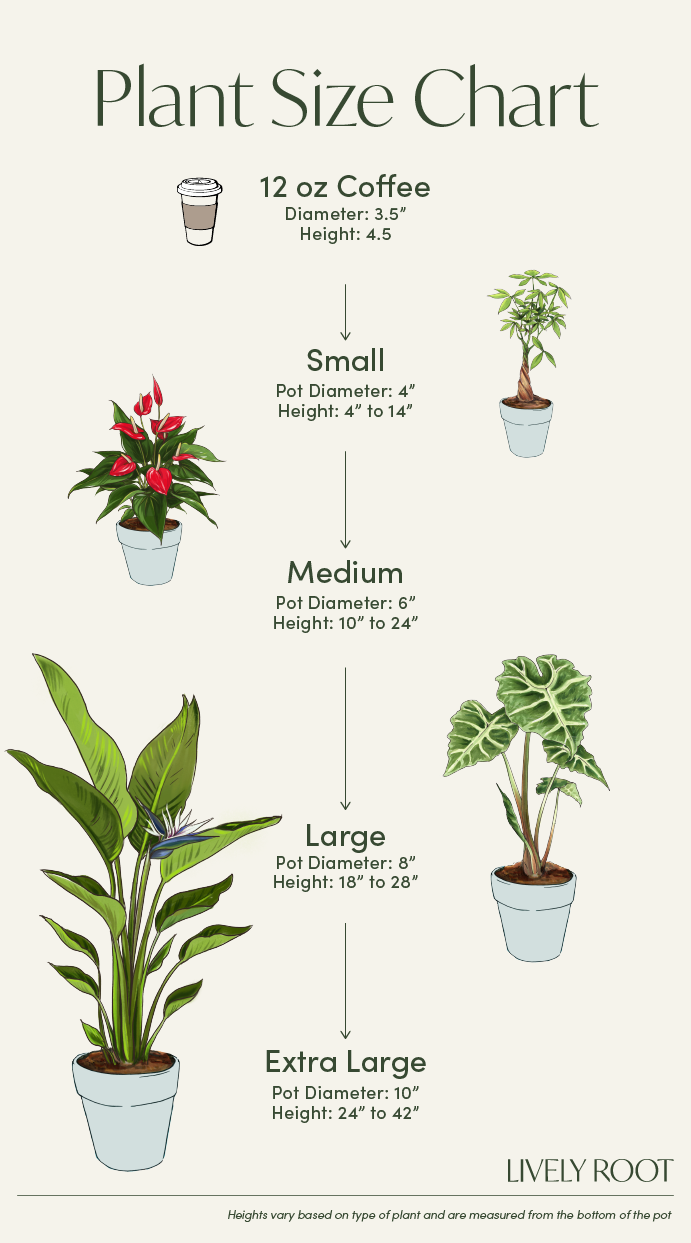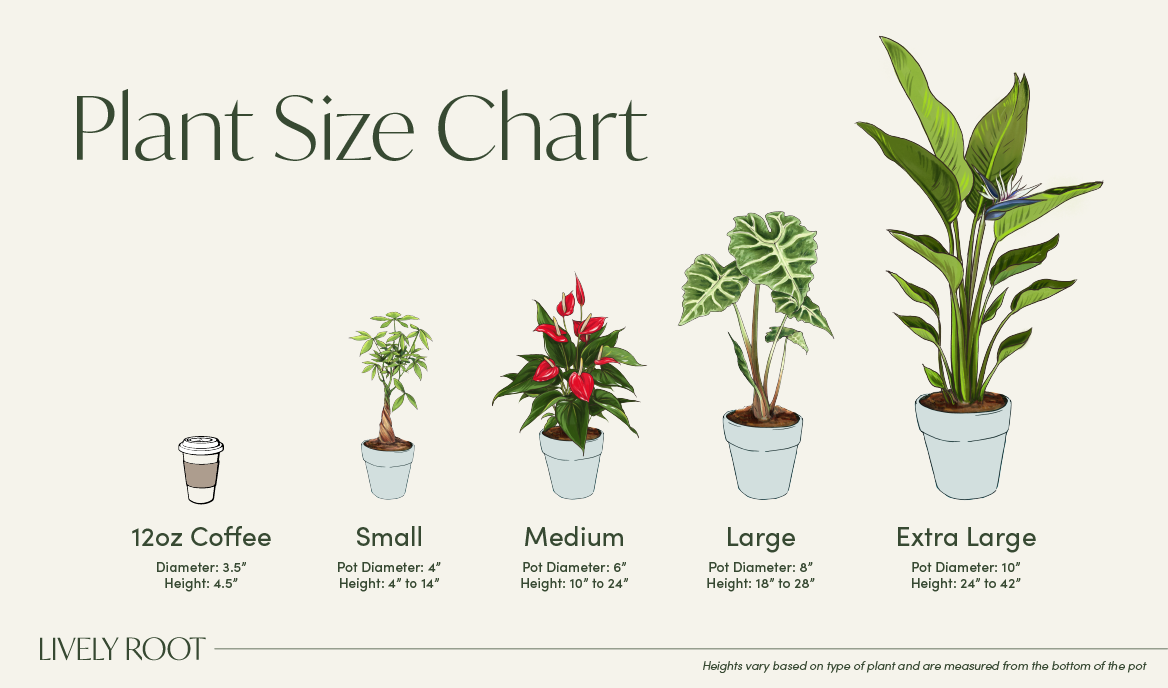

This cute Pineapple Plant (Ananas comosus) is perfect for any space with bright but indirect sunlight. Add it to your sunroom decor or elevate your living room and enjoy its delicious fruit once ripe. Save the top, replant it, and wait for a new one to grow. The pineapple tree is one of the easiest tropical plants to care for!
*Fruit size may vary; sit back and watch your fruit grow!
Pineapple Plant Care Guide & Presentation

Enjoys bright, indirect light.
Water thoroughly when the soil surface is dry, but avoid making them soggy.
Thrives in high levels of humidity.
Temperatures cooler than 28°F will kill this plant. Cover and protect this plant from sudden drops in temperatures or bring them inside.
Outside: Grow in partial to full sun (4-8 hours) where nights are above 45°F.
Indoors: The pineapple prefers bright, indirect light for at least six hours in a southern, eastern and western windows.
Apply a balanced fertilizer that is water soluble. Soak the soil being careful not to wet the leaves on the plant. Fertilize all around the plant in different spots making sure all the roots get food.
When receiving the plant, do not repot immediately but wait at least 6-12 months.
Repot in the spring, using a 2" wider pot. Use a well-draining indoor potting mix with perlite to help with drainage. Place a piece of screening at the bottom of the container over the drainage hole to secure the soil and allow to drain. Water your plant in the old pot and let sit an hour before transferring.
Add soil to the bottom to elevate the root ball. Lift the plant and release the roots against the existing planter. Use a clean knife or garden trowel to wedge between the pot and the soil to loosen.
Inspect the root ball. Notice if there are any dead or rotting roots and trim off with sterile pruners. If the plant is rootbound, cut through the roots to alleviate continued encircling.
Ensure the plant is sitting about 1" below the edge of the pot to avoid water spillage. Add more soil and backfill around the sides by tamping down. Fill up to the soil line but not over.
Water thoroughly, leaving the soil damp but not soggy. If settling occurs, add more soil. You may observe some leaf changes as they acclimate to their new environment. They may suffer some transplant shock depending on how tight the roots were intertwined together. Trim off any declining leaves as they regain energy and gets rooted into the soil over time.
Using a sharp knife, trim off any dead or damaged leaves from the bottom half of the plant to keep energy moving to the healthy leaves. Shower the leaves using a watering can with filtered or rainwater to remove dust. Remove any debris on the soil and replenish soil if needed.
Cut about half an inch below the leafy top of the pineapple. At the bottom of the stem should be root buds or brownish bumps.
Peel the lower leaves by pulling downward around the stalk by an inch.
Let the top heal for several days before planting.
Use a well-draining soil mix with perlite added for good drainage.
Place the stem in the soil and add additional soil around them up to the leaves, and water the soil thoroughly.
Keep the rots moist as the roots establish. Place them in medium to bright indirect light.
Check on them in eight weeks to see if the roots have anchored by tugging on the leaves.
Pineapple Plant: Overview
The Pineapple Plant (Ananas comosus) is a bushy tropical plant with thick, spiky leaves. It grows a central stalk with an edible pineapple fruit on top. Although the Pineapple may resemble a small palm tree in shape, the plant isn’t a tree or bush but a terrestrial bromeliad. The edible Pineapple plant is also known as Bromelia comosa or Ananas ‘Mi Amigo’.
Pineapple plants can grow up to 3-4 ft. in height. Native to South America, the Bromeliad Pineapple plant requires a warm and humid environment and can be grown outdoors in hardiness zones 10-11. It takes a Pineapple plant about 3 years to reach maturity and start to bloom (if the conditions are right). It usually lasts for 5 to 7 years.
The pineapple inflorescence looks like a red or deep pink pineapple fruit, but the actual flowers are tiny, purple blooms hidden in the fold of each spike. Pineapples are easy-to-care-for plants. They love the sun and need plenty of water. Because of their shallow root system, Pineapple plants can grow fast in a pot.
While the Pineapple Ananas is considered non-toxic to pets, its unripe fruit can cause mouth, throat, and stomach irritation in pets and small children.
In Chinese culture, pineapples symbolize warm welcome and hospitality and are believed to bring good luck. According to Feng Shui, they attract abundance and promote well-being.
Pineapple Plant: Benefits
- Great air-purifying plant that removes toxins and produces oxygen at night
- Adds an exotic appeal and tropical vibe to any space
- Easy-care plant
- Popular symbol of abundance and hospitality
- Gorgeous edible fruits with numerous health benefits
- Fun gift plant
Pineapple Plant: Care Guide
The Pineapple plant care is surprisingly easy. Here are some key tips to get you started:
Watering and Humidity
Finding the right balance in watering is often key to growing a pineapple plant successfully. Water your pineapple plant regularly and abundantly once the top soil layer gets dry. Keep the soil from getting soggy, however. As a tropical plant, the Ananas needs plenty of humidity. To increase humidity, mist your indoor Pineapple plant, group it with other plants, or place the pot on a pebble tray.
Light and Temperature
The Ananas plant needs 6-8 hours of bright, indirect light. It grows best in warm temperatures from 68℉ to 85℉. If you intend to grow your plant outdoors on the porch, always bring it indoors if the night temperatures drop below 45°F.
Soil, Feeding and Repotting
Choosing the right soil for your Ananas comosus is important to prevent overwatering. Plant it in well-draining, rich soil mixed with perlite for enhanced drainage. Feed your Pineapple tree regularly with a well-balanced fertilizer.
Most Pineapple plants won’t need repotting for 6-12 months after purchase. Before you repot your plant, water it well the previous day. Use a 2-inch larger pot to provide space for the roots. Trim any damaged or rotting roots with sterile pruners.
Pineapple Plant: Propagation
You can quickly propagate your Pineapple Bromeliad plant by cutting off the leafy top of your pineapple fruit. Remove the fruit flesh and peel off the lower leaves. Let the cut top callus for several days, and then plant in moist, well-draining soil. Place the new plant in bright, indirect light. Keep the soil consistently moist. You can also propagate your plant via suckers.
Pruning, Cleaning, and Common Issues
Prune any wilting or damaged leaves on your plant. It’s normal for the lower leaves to wilt after repotting or aging to make way for new leaves, so remove them carefully. Shower your plant to remove dust once in a while. Yellowing leaves can indicate overwatering or lack of light.
Ananas Comosus: Placement, Companion & Alternative Plants
Whether you grow your Pineapple plant outdoors or indoors, its eye-catching beauty will enhance your home and lend it unforgettable tropical charm.
Best Locations & Uses
- Ideal for beginner indoor gardeners
- It makes the perfect entryway plant
- Wonderful bedroom plant because of the oxygen it produces during the night
- It is ideal as a porch plant for humid and warm environments
Companion Plants
Grouping your Ananas with other humidity-loving plants is a beautiful way to increase air moisture around them:
- Flamingo Flower (Anthurium spp. – Red): The vibrant Flamingo Flower adds a festive, tropical mood to any space with its bright red, long-lasting inflorescences.
- Dieffenbachia Camille (Dieffenbachia Camille): With its lovely, green-white leaves, the Dieffenbachia Camille is a charming addition to your indoor plant collection.
- Coconut Palm Tree (Cocos nucifera): Another pet-friendly plant with edible fruit, the Coconut Palm is full of exotic charm.
Alternative Plants
If you like the Pineapple plant’s exotic look but want to consider other similar plants, here are some ideas we’ve picked for you:
- Evita Vriesea Bromeliad ('Evita' Vriesea splendens): The amazing Evita Vriesea Bromeliad has sword-shaped, long-lasting blooms in various vibrant colors.
- Good Luck Plant (Cordyline fruticosa Glauca): The easy-care, air-purifying Good Luck Plant will bring an exotic and lush ambiance into any living space with its crown of elegant, curved leaves.
- Vriesea Bromeliad (Vriesea splendens): Another stunning bromeliad plant, the Vriesea Bromeliad will enchant you with its striped leaves and fiery red flower.
Bring the Tropics at Home With a Pineapple Plant from LivelyRoot Today!
Get a Pineapple plant with fruit from Lively Root to create your jungle paradise!












































